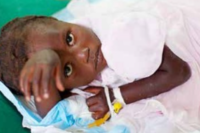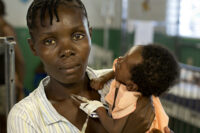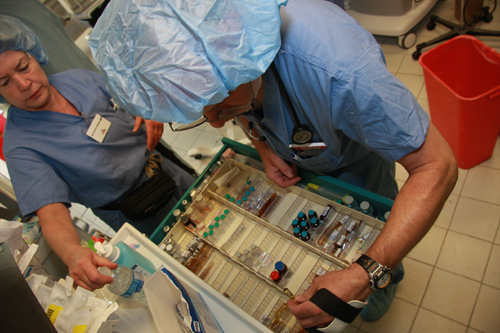 Report by Nadine Pierre Louis MD, Internist
Report by Nadine Pierre Louis MD, Internist
Department of Internal Medicine, Hôpital Sacré Coeur
A 24-year-old woman was admitted to the Department of Internal Medicine at Hôpital Sacré Coeur during the month of February, 2013, with symptoms progressive shortness of breath (dyspnea) upon exertion, chest pain and cough. The symptoms developed over 2 weeks after giving birth to twins at home. This twin pregnancy was the patient’s first pregnancy and had no other complication before delivery.
On first examination the patient presented with shortness of breath lying down (orthopnea) and a prominent swelling of the jugular neck veins. Blood pressure was 100/70 mmHg, heart rate of 124 beats minute (elevated), respiratory rate of 40 per minute (elevated), oxygen a saturation low at 88% and a temperature of 36 degrees Centigrade. There was painful enlargement of the liver, a positive hepato-jugular reflux sign of heart failure (pressure over the liver produces swelling of the neck veins which reflects overload on the connecting pulmonary vein which in turn is backed up because of failure of the right side of the heart to pump efficiently) and significant swelling (oedema) of the lower limbs. Cardiac auscultation noted a gallop of B3 (a third sound Lub Dub TA when heart does not fill enough to reverberate normally), a murmur during left ventricle contraction 3/6 best heard at the apex (lower tip of the heart), as well crackles at both lung fields (indicates fluid buildup).
Lab testing indicated:
¬ The electrocardiogram: sinus tachycardia left Atrio-ventricular hypertrophy (enlargement)
¬ Chest X-ray: cardiomegaly, vessel stasis, the cardio thoracic chest ratio= 0.65.
¬ Red Blood Cell 4,670,000 /mm3 Hemoglobin =7.4 g/dl, Hematocrit= 38.9%, White Blood cells =5, 9000/mm, Neutrophils Polynuclear 3 52%, Lymphocytes =46%, Eosinophils= 3%.
¬ Echocardiography Impression: (ultrasound evaluation of cardiac activity)
• Severe expansion left ventricle
• Moderate expansion right ventricle
• Overall decreased motion
• Moderate dilatation of the left and right Atria
• Moderate mitral valve regurgitation
• Less than 25% blood ejection fraction
• Minimal pericardial effusion
• Diameter ventricular diastolic TV: 5.48 cm/m2
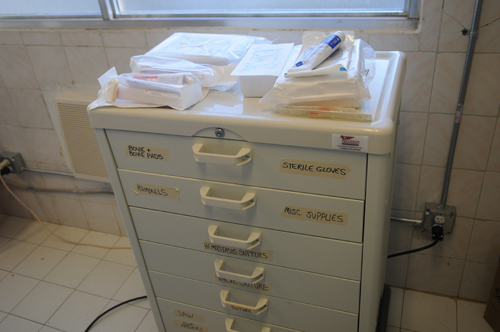 DR LOUIS: “What diagnoses are likely from this information? What is supporting data?”
DR LOUIS: “What diagnoses are likely from this information? What is supporting data?”
We can talk about heart failure in a black woman in period of postpartum of a twin pregnancy with no particular medical history. This table allows us to evoke a diagnosis of cardiomyopathy of post partum (CMPP) occurring in general in the context above-cited, and called The Still Syndrome of Meadow first described in 1957.
-To the HSC in the last 6 months (November 2012 to March 2013) we have had about 540 live births and 13 cases of PPC including a likely pulmonary embolism death. The average age of the patients was 25 years.
Treatment
The treatment prescribed in our patient included the association of (rest, diet) lifestyle and dietary measures of the loop diuretics, nitrates and converting enzyme inhibitor. A systematic anticoagulation was seen because of the high thrombosis risk. As soon as the hemodynamic stabilization was achieved beta-blockers (carvedilol, bisoprolol) have been introduced. In industrialized countries other adjuvant therapies are used: corticosteroids and immunoglobulins.
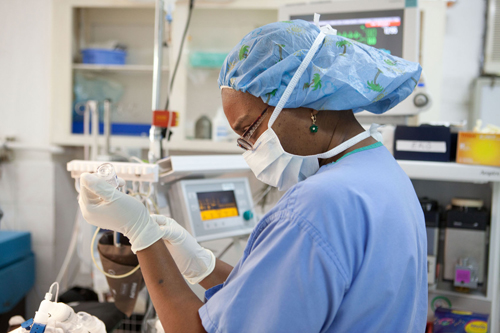 Conclusion
Conclusion
Peripartum cardiomyopathy is a cardiomyopathy rare but quite present in the black race and in countries with low economic resources such as Haiti. It is associated with a high rate of morbidity and mortality. Its definition, standardized by the National Heart Lung and Blood Institute in 1997, describes the presence of heart failure occurring in peripartum and until the 5th month of post partum, in absence of any other cause of heart failure and in the presence of echocardiography of dilatation of the left ventricle; 45% ejection fraction and diameter TV diastolic 2.7 cm/m2 of surface body. The evolution under treatment was favorable for this patient who continues to be followed regularly at Hôpital Sacré Coeur.





